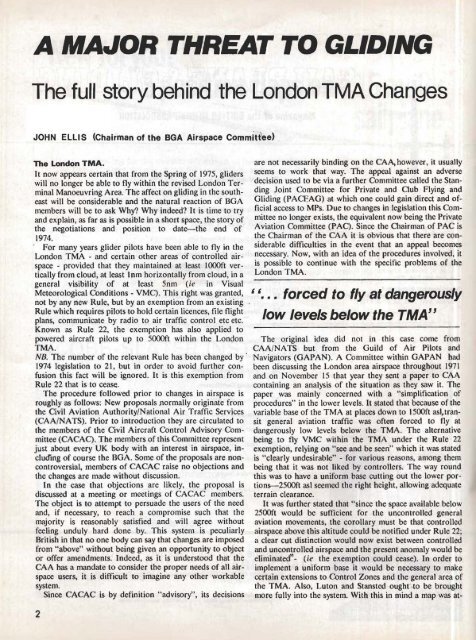Volume 26 No 1 Feb-Mar 1975.pdf - Lakes Gliding Club
Volume 26 No 1 Feb-Mar 1975.pdf - Lakes Gliding Club
Volume 26 No 1 Feb-Mar 1975.pdf - Lakes Gliding Club
You also want an ePaper? Increase the reach of your titles
YUMPU automatically turns print PDFs into web optimized ePapers that Google loves.
A MAJOR THREAT TO GLIDINGThe full story behind the London TMA ChangesJOHN ELLlS(Chairman of the BGA Airspace Committee>The London TMA.It now appears certain that from the Spring of 1975, gliderswill no longer be able to fly within the revised London TerminalManoeuvring Area. Tbe affect on gUding in the southeastwill be considerable and the natural reaction of BGAmembers will be to ask Why? Why indeed? It is time to tryand explain, as far as is possible in a short space, the story ofthe negotiations and position to date-the end of1974.. For many years glider pilots have been able to fly in theLondon TMA - and certain other areas of controlled airspace- provided that they maintained at least 10000t verticallyf.rom cloud, at least lom horizontally from cloud, in ageneral visibility of at least 5nm (ie in VisualMeteorological Conditions - VMC). This right was granted,not by any new Rule, but by an exemption from an existingRule whi'Ch requires pilots to hold certain licences, file flightplans, communicate by radio to air traffic control etc etc.Known as Rule 22, the exemption has also applied topowered aircraft pilots up to 5000ft within the LondonTMA.NB. The number of the relevant Rule has been changed by'1974 legislation to 21, but in order to avoid further confusionthis fac,t will be ignored. It is this exemption fromRule 22 that is to cease.The procedure followed prior to changes in airspace isroughly as follows: New proposals normally originate fromthe CMI Aviation Authority/National Air Traffic Services(CAA/NATS). Ptior to introduction they are circulated tothe members of the Civil Aircraft Control Advisory Committee(CACAC). The members of this Committee representjust about. every UK body with an interest in airspace, includingof course the BGA. Some of the proposals are nonconlroversical.members of CACAC raise no objections andthe changes are made without discussion.In the case that objections are likely, the proposal isdiscussed at a meeting or meetings of CACAC members.The object is to attempt to persuade the users of the needand, if necessary, to reach a compromise such that themajority is reasonably satisfied and will agree withoutfeeling unduly hard done by. This system is peculiarlyBritish in that no one body can say that changes are imposedfrom "above" without being given an opportunity to objector offer amendments. Indeed, as it is understood that theCAA has a mandate ~oconsider the proper needs of all airspaceusers, it is difficult to ,imagine any other workablesys'tem.Since CACAC is. by definition "advisory", its decisions2are not necessarily binding on the CAA, however, it usuallyseems to work that way. The appeal against an adversedecision used to be via a further Committee called ,the StandingJoint Committee for Private and <strong>Club</strong> Flying and<strong>Gliding</strong> (PACF,AG) at which one could gain direct and officialaccess to MPs. Due lo changes in legislation this Committeeno longer exists, the equivalent now being the PrivateAviation Committee (PAC). Since the Chairman of PAC isthe Chairman of the CAA it is obvious that thete are considerabledifficulties in the event that an appeal becomesnecessary. <strong>No</strong>w, with an idea of the procedures involved, itis possible to continue with the specific problems of theLondon TMA., '. .. forced to fly at dangerouslylow levels below the TMA"The original idea did not in this case come fromCAA/NATS but from the Guild of Air Pilots andNavigators (GAPAN). A Committee within GAPAN hadbeen discussing the London area airspace throughout 1971and on <strong>No</strong>vember 15 that year they sent a paper to CAAcontaining an analysis of the situation as they saw it. Thepaper was mainly concerned with a "simplification ofprocedures" in the lower levels. It stated that because of thevariable base of the TMA at places down to I500ft asl~transitgeneral aviation traffic was often forced to fly atdangerously low levels below the TMA. The alternativebeing to fly VMC within the TMA under the Rule 22exemption, relying on "see and be seen" which it was statedis "clearly undesirable" - for various reasons, among thembeing that it was not liked by controUers. The way roundthis was to have a uniform base out,ting Gut the lower portions-2500ftasl seemed the right height, allowing adequateterrain clearance.It was further stated that "since the space available below2500ft would be suffici'ent for the uncontrolled generalaviation movements, the corollary must be that controlledairspace above this altitude could be notified under Rule 22;a clear cut distinction would now exist between controlledand uncontrolled airspace and the present anomaly would beeliminated"- (ie the exemption could cease). In order toimplement a uniform base it would be necessary to makecertain extensions to Control Zones and the general area ofthe TMA. Also, Luton and Stansted ought to be broughtmore fully into the system. With this in mind a map was at-

















